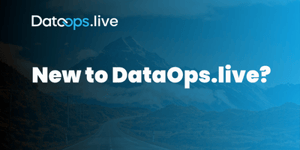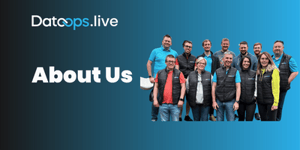
Should you build or buy your DataOps Tech Stack?
Pros and cons, costs, and getting the best business value
As organizations embark on their DataOps journey, they are confronted with a fundamental decision: buy a DataOps platform or build their own solution. In this piece, we’ll explore the question (though you shouldn’t be surprised that our final recommendation is to sign up for DataOps.live).
“Build vs buy” is a nuanced decision for any business software, not just DataOps. SaaS solutions offer distinct benefits, including rapid deployment, lower upfront costs, and access to expert support. On the other hand, as engineers, building is always a tempting option. DIY solutions allow infinite customization, control, and alignment with specific business needs.
To explore the question of building vs buying a solution, let’s look at:
— Pros and cons of building vs buying
— Costs of building vs buying software
— Speed to market with building vs buying
— Security considerations for DIY vs SaaS
— Why Snowflake doesn’t DIY DataOps
— The origin of DataOps.live
Build vs Buy pros and cons at a glance
There are a lot of reasons it might be tempting to build tools for yourself. Engineers like to build. Lines of business want software with their business requirements baked in, and everyone thinks their requirements are highly unique.
However, building a new solution—in DataOps or in other areas—often requires skills beyond the engineering team’s core competencies. It also risks distracting them from the core business and pulling engineering resources away from strategic business initiatives.
Pros and cons of building custom software:
PROS
- Infinite customization possibility
- You have total control of the roadmap
- Tailored to your exact business needs
- Provides complete control of your data
CONS
- Longer lead time and starting with MVP
- Higher costs, especially initial development
- Requires ongoing support and maintenance, distracting (or impeding) core business initiatives.
- Relies on institutional knowledge
- Greater risk of errors or project failure
- You are responsible for security and compliance
Pros and cons of buying software:
PROS
- Faster time to value
- Full-featured from the start
- Lower up-front cost
- Dedicated support and less work for your engineering team
- Roadmap influenced by industry leaders
- Scalability
CONS
- You may influence the roadmap but don’t control it
- Customization depends on partnership with the vendor
- A subscription model may appear to cost more over the long run
- Need to vet vendors for security and data protection
A specialized software company devotes more time and attention to trends and opportunities than your engineering team can. After all, your team needs to keep the rest of your business running smoothly.
If you aim to build an empire with proprietary tools, by all means, build your own software in-house. But if your goal is to deliver on the business's strategic needs, it’s worth at least evaluating what’s on the market.
We can’t say that all software vendors are created equal. But when you buy a DataOps platform like DataOps.live, you’re buying an proven and tested, enterprise-grade tool from market leaders.
Cost comparison: Build vs Buy
Most people have a number in mind as the build cost for an in-house tool. “The engineers told me they could build it in 4 months,” they’ll say, and plan their budget from there.
Wouldn’t you know it, that approach turns out to be a little simplistic—and often quite optimistic.
McKinsey found that, on average, large IT projects deliver disappointing results:
- 7% over schedule
- 45% over budget
- 56% less value than predicted
- 17% go so poorly they “threaten the very existence of the company”
Engineers’ estimates for custom software development are usually well under the actual time to build. Budgets often fail to account for incidental costs. It’s also important to factor in the maintenance costs year after year, especially the costs for experienced engineers to keep the platform running well (and maybe even enhance it). Over time, the difference in maintenance cost will far outstrip savings during the build phase.
According to 2022 research by CISQ, US businesses spend $607 billion annually to deal with software defects. And that’s only the projects that succeeded. The same report found that $260 billion was spent on unsuccessful projects.
Here’s a better way to break down the costs of building vs buying your software solution:
Cost considerations when you build software in-house
- Break down the initial development costs, including hardware, software licenses, developer salaries, and overhead
- Add in long-term costs associated with maintenance, updates, new features, and scalability
- Calculate the opportunity cost of waiting to build your own solution vs buying one
Cost considerations when purchasing software
- Compare subscription tiers and costs for SaaS platforms
- Extrapolate Total Cost of Ownership over a defined period, say 3–5 years
- Factor in the time to value (TTV) compared to the delay if you were to build it yourself
Off like a rocket: How DataOps.Live brought OneWeb’s vision to reality in just 6 weeks.
Speed to market: Building vs. Buying software
As mentioned above, McKinsey found that the average big IT project runs 7% over time. Based on our collective software experience at DataOps.live, it typically takes 3–6 months to design, build, productize, and deploy a prototype (or MVP—minimum viable product). It takes another 6+ months to make it fit for purpose, scalable, reliable, and secure—assuming the project doesn’t simply fail.
In contrast, buying a product means you’ll get a complete solution built by a dedicated team with expertise in that type of software.
Building software in-house tends to be slower
- Time required for design, development, testing, and deployment phases
- Resource management to maintain regular operations during the project
- Potential delays due to unforeseen challenges or changes in requirements
Buying software tends to be faster
- Professionally-made SaaS solutions intended for rapid deployment
- Timelines you can trust based on case studies from vendor’s existing customers
- Enterprise support for onboarding means faster adoption
Speed isn’t just about convenience. Rapid deployment means faster time to value. In DataOps, that means the ability to deliver data products at the speed your business demands.
With DataOps.live, Roche Diagnostics reduced its average MVP lead time from 6 months to 4-6 weeks and went from releasing 1 product every quarter to 120 every month. If Roche had spent 3-6 months building its prototype and another six months optimizing it, Roche’s DataOps team would have missed out on up to a year of 4–6x speed and 360x productivity!
Security considerations: DIY vs. SaaS
There was room for nuance in the question of cost and speed when building or buying software. When it comes to security, things are a little more black and white. That’s because building and maintaining security is so much more specialized, and so much more critical to the functioning and health of your business.
At DataOps.live, we deal with at least 50 security patches per month. You'll need to do the same thing if you want to build your own DataOps solution with the same technologies. You will need a team whose entire job is nothing but security patches. Since the worldwide cybersecurity workforce is short nearly 4 million professionals, that may be even more of a challenge than you’d think.
Your homegrown software will have vulnerabilities if you don’t want to do that or can’t afford the resources.
Security considerations for a DIY DataOps platform:
- Challenges in implementing robust security measures, including encryption, access controls, and compliance certifications
- Risks associated with data breaches, compliance violations, and inadequate security protocols
- Cost to keep up with a fast-moving ecosystem
Security assurances with DataOps.live:
- Security and compliance, including data encryption in transit and at rest, regular security audits, and SOC2 compliance certification
- Updates and security patches pushed out automatically
- Assurance of data protection and regulatory compliance
- Recognition as a Snowflake Elite Tier Partner proves we’ve passed Snowflake's high standards for performance, reliability, and security

"It is now essential that organizations can move data from a multitude of sources to a unique and centralized location like the Snowflake Data Cloud while maintaining the performance, flexibility, and scalability they need to load, integrate, analyze, and share their data—securely. The DataOps.live Platform has long been a key component to helping Snowflake customers achieve this so they can drive and deliver more accurate business decisions."
Snowflake itself decided to buy DataOps.live
Snowflake is no stranger to building its own software solutions. The company is chock-full of skilled software engineers, and its culture is steeped in data. So when Snowflake’s Sales Engineering team needed a solution to roll out data products, they planned to build a solution in-house.
Snowflake assembled a team and started building out content, but before long, they realized that rolling out assets for hundreds of Sales Engineers and partners to use on their own machines and Snowflake accounts would be wildly complicated.
Vernon Percival Tan, Senior Manager of Snowflake’s Frostbyte Industry Solutions, tried everything: “We exhausted every possible option that didn't involve partnering with a company or purchasing a tool or platform… but that comes with its own cost: technical debt, staffing requirements…it was very very onerous, very difficult.” Even for Snowflake, building a data platform simply didn’t make sense.
Fortunately, Vernon and his team didn’t have to go far for help. DataOps.live has been a Snowflake technology partner since 2017. “DataOps.live delivered in a massive, massive way,” Vernon says, “and we couldn't imagine where we'd be now without their partnership.”
Learn more about the Snowflake Solutions Center.
We built it so you don’t have to
When Justin Mullen and Guy Adams founded DataOps.live, they had no choice but to build DataOps software themselves. Today, you do have a choice.
Our platform was born from nearly a decade of professional services, hundreds of successful data projects, and a belief in #TrueDataOps principles.
DataOps.live is the only DataOps platform built purely for Snowflake. DataOps.live is built to satisfy the real demands of modern, data-driven companies using Snowflake.
DataOps.live removes the challenge of balancing agility and governance, delivering fundamental improvements in both. DataOps.live solves for 100% of your DataOps lifecycle with Snowflake.
✔ Agility and governance without compromise
✔ End-to-end orchestration from ELT to environment management
✔ CICD and automated testing
✔ An elegant user interface (UI)




